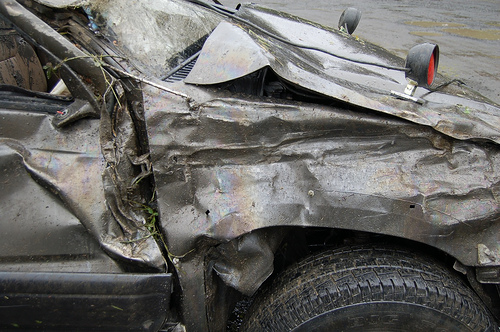Wasted prom: How drunk driving is hurting high schoolers
Teens in Pataskala, Ohio and New York State were recently urged to come back to school – alive. Anti-drunk driving programs are being delivered to a variety of high schools at a prime time, as students prepare for the upcoming prom season. And though reports suggest that drunk driving is down for this age group compared to earlier generations, teen drunk driving remains a pressing issue: In a 2011 national survey, 24% of teens reported that they had ridden with a driver who had been drinking alcohol within the past month. Meanwhile, motor vehicle crashes remain the top cause of death among American teens aged 16 to 19.

Car accidents are the main cause of death for teens. The traditional misbehavior that go with prom season adds fuel to the fire. Via Matt Lemmon.
As reported by the Newark Advocate, 550 students at Watkins Memorial High School watched a stark portrayal of a car crash, featuring local firefighters and medics – plus fellow students, who volunteered to don fake blood and imitate injuries and death. Sponsored by a parent group, the program also featured a particularly relevant speaker. Aaron Cooksey spoke about the one decision that continues to haunt him over a decade. A former talented athlete, Cooksey became heavily involved in drinking and drugs while in college. In July 2001, he was driving his truck after drinking. The truck flipped three times, then twisted around a telephone pole. The crash killed his passenger and best friend, Andrea. “The first thing I think about every day is the crash; the last thing I think about every day is the crash,” Cooksey told students.
Other high schools are offering similar measures. In the Twin Tiers community of New York and Pennsylvania, high schools are staging alcohol-free after-prom parties. At Watkins Glen High School, the district attorney’s office speaks with seniors about safety, and sends letters to parents explaining punishments for hosting parties with alcohol available. At Candor High School, the student group, Students Against Destructive Decisions recently held “Reaper Day,” an annual event that drives home the reality of drunk driving fatalities – students are representatively “killed” by being tapped on the shoulder at the end of every period to illuminate the number of youth fatalities. “It brings a dose of reality. At this age, the students think they are invincible,” Colleen Grebleski, Chemung County STOP DWI coordinator, told PressConnects.com.

Schools are getting creative to combat risky behavior among teens. From uberculture.
The necessity of these initiatives is backed by statistics. A 2009 study by the National Institute of Drug Abuse, National Institutes of Health and the U.S. Department of Health & Human Services, affirms just how common drinking is among teens. Almost 75 percent of students have consumed more than just a few sips of alcohol by the end of high school, and thirty-seven percent have done so by eighth grade. The Century Council, an advocacy group, reports that as of 2012, 42% of 12th graders – seniors, who often attend prom – drank within the last month.

With drinking rates among teens sky-high, it’s crucial find new ways to urge them to drive sober. From roadtrafficsigns.com.
The numbers are even more dramatic for a wider swath of underage drinkers: Ten million kids, ages 12 to 20, in the U.S. report that they have consumed alcohol within the past 30 days.
Category: News & New Products, Road safety, Traffic law















Comments (4)
Sites That Link to this Post